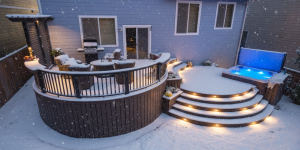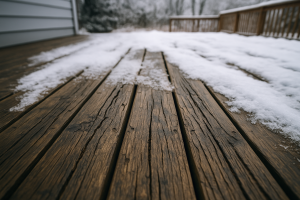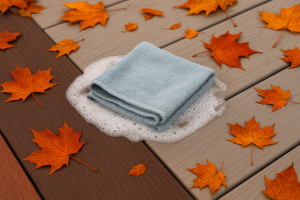Building a deck around a tree or other natural elements in your backyard can be a visually appealing and eco-friendly addition to your outdoor space. However, doing this requires careful planning and proper techniques to ensure both the tree’s continued health and the stability of the deck.
In this article, we will cover the benefits of building your deck around trees and offer essential tips and steps to guide you through the process.
Why Build a Deck Around Trees?
1. Enhanced Aesthetics
Building a deck around a natural element in your yard, like a tree, can create a visually stunning and unique outdoor space. It allows you to incorporate the natural beauty and shade provided by the tree, resulting in a harmonious blend of artificial structures and nature.
As most trees and plants will have colourful leaves, for at least part of the year, this design will also add a pop of colour to your overall deck space.
A deck built around a tree is not only a distinctive design element but it also becomes a focal point in your outdoor space. It can add individuality to your deck and enhance the overall aesthetics of your property.
2. Increased Shade and Comfort
The presence of a large tree within the deck area provides natural shade, making the space more comfortable during hot summer days. This added shade allows you to enjoy your deck even in intense sunlight. The shade also protects your deck from UV rays, which can be damaging, even for composite and PVC decks.

3. Environmental Benefits
Trees offer a range of environmental benefits, including air purification, reducing soil erosion, and providing a habitat for wildlife. By building a deck around a tree, you are actively preserving and appreciating these natural benefits, contributing to a healthier ecosystem.
4. Privacy and Sound Barrier
Depending on the location and size of the tree, building a deck around it can offer increased privacy, shielding your deck from neighboring views. The tree can also act as a natural sound barrier to reduce overall noise levels.
5. Improved Emotional Well-Being
Being in nature and surrounded by trees has been shown to have positive effects on mental health and well-being. Building a deck around a tree provides a space where you can relax, unwind, and reap the emotional benefits of being in a natural environment.
What to Consider if You Want to Build a Deck Around a Tree
1. Assess the Tree’s Health and Structural Stability
Before beginning any construction, assessing the tree’s health and structural stability is crucial. Consult with an arborist to evaluate the tree’s condition, check for any signs of disease, and determine if it can withstand the construction process.
2. Selecting the Right Deck Design
Once you’ve determined the tree is healthy and stable enough to build around, you need to choose a deck design that allows for the tree’s growth and movement while maintaining a stable structure.
The deck should be flexible to accommodate the natural growth of the tree while preventing any damage to the deck or the tree’s roots.
When planning a design, you need to consider the tree’s mature size and growth patterns. Choose a design that allows the tree to continue growing in full without obstruction or damage to the deck structure.
A great way to achieve this is by opting for a design that incorporates flexible components. These can include gaps or spacing between deck boards to accommodate the natural movement of the tree.
3. Determining the Size and Location of Your Deck
Begin by carefully measuring the tree’s trunk diameter. Use these measurements to help determine the size and shape of the deck. Remember to leave enough space around the tree to accommodate growth, accounting for both vertical and lateral growth. Your number one priority needs to be not hindering the tree’s development.
Also, consider factors like sunlight, shade, and wind patterns when deciding on the deck’s location. A primary benefit of building a deck around a tree is the shade you gain from the canopy.
Therefore, you’ll want to optimize the deck’s location around the tree to get the most shade coverage and protection from the wind. Don’t forget to think about patterns of sunlight on the deck throughout the day as well.

4. Protecting the Tree’s Root System
The tree’s root system is vital for its stability and overall health. When building your deck around nature, you need to ensure you don’t damage the tree’s roots during construction. You can avoid this issue by carefully digging around them and using hand tools or specialized equipment to minimize damage.
You can also opt for innovative techniques like building an elevated deck or using adjustable supports that minimize the impact on the roots and allow them to grow and expand naturally.
5. Ensure Proper Drainage
Another must-do when building decks around natural elements like trees is incorporating proper drainage mechanisms to prevent water accumulation around the tree’s base. This drainage will help maintain a healthy environment for the tree and prevent moisture-related issues, such as root rot.
One way to achieve this is by sloping the deck surface away from the tree, or using perforated drainage pipes to divert water away. In addition, avoid creating structures or barriers that may impede natural water flow to the tree’s roots.
6. Regular Maintenance and Care
Once the deck is constructed, it’s essential to continue caring for both the tree and the deck. Regularly inspect the tree for signs of stress, disease, or pests, and address any issues promptly.
Additionally, maintain a wooden deck by regularly cleaning and sealing the wood to ensure its longevity. As you’ll have leaves falling onto your deck, make sure you sweep these leaves up frequently, no matter what type of material your deck uses.
Uncleared leaves can result in mold and mildew. While wooden decks may sustain more damage, mold and mildew can still cause issues with PVC or composite decks.
To learn more about deck maintenance, read our summer deck cleaning and maintenance article.
Why Use PVC or Composite Decking for Your Deck Around a Tree?
1. Environmental Considerations
If you’re planning to incorporate trees in your deck design, it’s likely because of your environmental consciousness. Therefore, going for a composite or PVC deck is the best option to keep your entire project as environmentally-friendly as possible.
Many composite and PVC deck boards are made with recycled materials and/or are recyclable, or incorporate other sustainable practices. By choosing these materials, you contribute to environmental conservation by reducing the demand for virgin wood and promoting the reuse of plastic or other recycled components.
For example, TruNorth Rice Hull Composite Decking is made using 95% recycled content and requires no trees be cut down.

2. No Harsh Chemicals
Using PVC and composite materials for a deck incorporating trees provides a practical and environmentally-friendly solution. These deck boards require no harsh chemicals for staining, painting, or cleaning, which helps keep your tree and the planet healthier!
3. Stability and Structural Integrity
Composite and PVC decking materials offer excellent stability and structural integrity. These factors are especially important to consider when building your deck around trees. A high level of stability is crucial to withstand the additional challenges posed by tree growth and movement.
Additionally, composite and PVC materials are less prone to warping, twisting, or cracking, which helps maintain the overall stability of the deck, especially when there might be uneven terrain or tree roots present.
4. Resistance to Moisture and Decay
Another benefit of composite and PVC decking materials is that they have an inherent resistance to moisture, rot, and decay. Moisture management is crucial when building decks around trees or other plants, as it prevents issues like rotting or mold growth. These issues can negatively impact both the deck and the tree.
Choosing materials that are resistant to moisture ensures a longer lifespan for the deck and minimizes the risk of moisture-related damage to the tree’s roots.

5. Visual Appeal
As noted above, building your deck around nature creates an interesting and very visually appealing design. For an added visual appeal, opt for composite and PVC decking materials.
These materials often retain a non-faded colour and high-quality appearance for a much longer period than wooden decks. Even when exposed to sunlight and outdoor elements, most composite and PVC decking brands boast anti-fade technology and even come with warranties against colour fade.
The long-lasting materials ensure that your deck will continue to enhance the overall appeal of your outdoor space, complementing the natural beauty of the tree, for years to come.
6. Fade and Stain Resistance
As just mentioned, composite and PVC decking are highly resistant to fading. They’re also both stain-resistant. If you incorporate a tree into your deck design, exposure to sunlight and potential leaf debris can lead to discoloration or staining on the deck surface.
Using fade and stain-resistant materials ensures that your deck retains its vibrant colour and appearance, despite prolonged exposure to the elements and leaf or other natural debris fall.
7. Pest Resistance
Composite and PVC decking are not appealing to pests, such as termites or carpenter ants. Quality pest resistance is especially beneficial in a deck surrounding a tree, as trees may attract pests.
By using materials that are resistant to pests, you minimize the risk of infestations and protect the structural integrity of the deck.

8. Easy Cleaning and Maintenance
Composite and PVC decking materials are not only easy to clean, but they also require minimal maintenance, especially compared to wood decking materials. If you have a tree integrated into your deck design, regular cleaning may be necessary to remove debris or fallen leaves.
The non-porous surface of composite and PVC decking makes cleaning with just soap and water a breeze, saving you both time and effort in maintaining your deck’s appearance.
9. Long-Term Cost Savings
While the benefits of using composite or PVC decking in your deck design might be attractive, you may be concerned about the cost comparison with wood. Fortunately, these materials offer significant cost-effectiveness over time.
The durability and longevity of composite and PVC decking material lead to substantial long-term cost savings. These materials may have a higher initial cost compared to traditional wood; however, their resilience against the elements and decay ensures you’ll have fewer deck replacements or repairs.
To put it in perspective, a wooden deck typically has a lifespan of around 10 years, while a PVC or composite deck can last 25 years or more, with minimal maintenance costs over that period. Wooden decks, on average, require paid repairs and maintenance every one to two years, adding significantly to the overall cost.
In Conclusion
Building a deck around a tree can be a stunning and unique addition to your outdoor space, allowing you to appreciate the tree’s natural beauty while creating a functional and inviting area.
By following the guidelines in this article, you can ensure your deck is constructed in a manner that respects the tree’s health, preserving both the tree and the deck’s stability for years to come. Remember, always consult with professionals, such as arborists or deck builders, to ensure a successful and harmonious integration of the deck and the tree.
In need of more inspiration for your upcoming deck project? Visit our ‘Get Inspired’ page, which boasts a variety of deck design ideas, including those that seamlessly incorporate nature.




